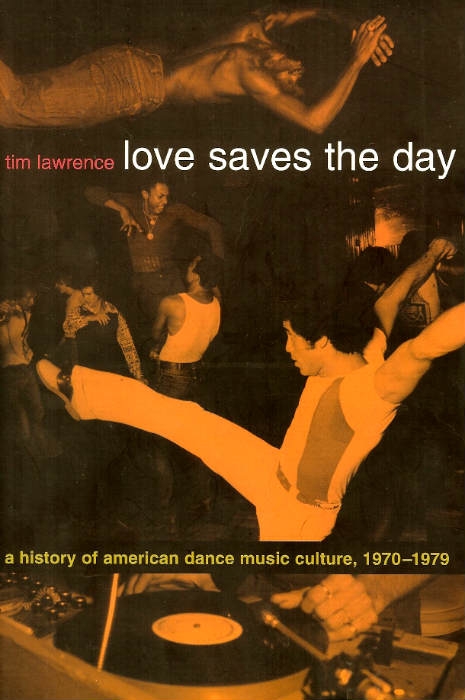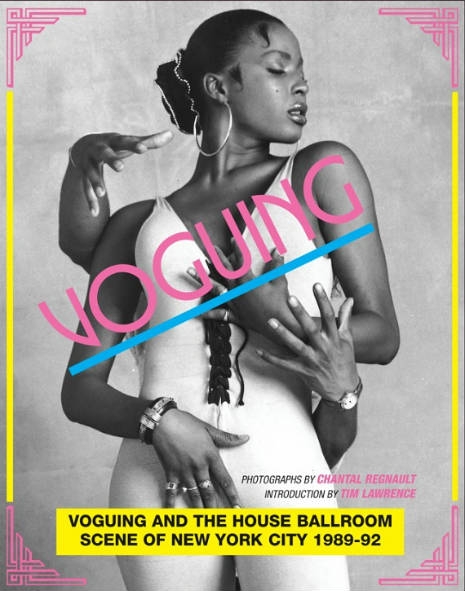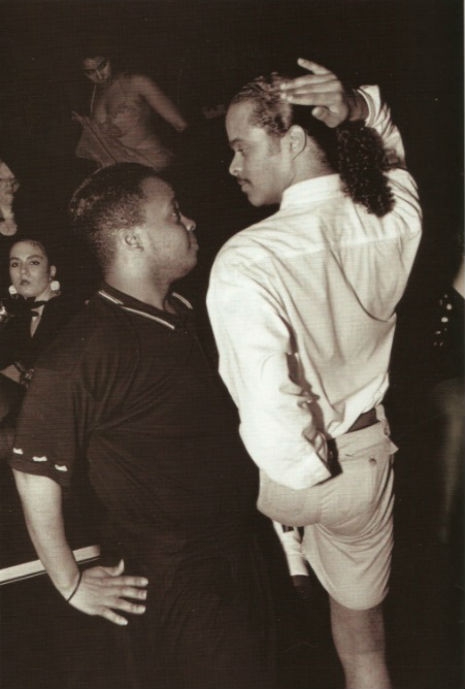
Many, many books have been written about disco, and I have read a whole bunch of them (including more well known works like Turn The Beat Around: The Secret History of Disco by Peter Shapiro, Everybody Dance: Chic and the Politics of Disco by Daryl Easlea and The Last Party: Studio 54, Disco and the Culture of the Night by Anthony Haden Guest) but still nothing comes close to matching Tim Lawrence’s exhaustive yet entertaining Love Saves The Day: A History of American Dance Music Culture 1970-79.
For those of you who still believe that disco was nothing more than an music-industry creation dreamt up in a backroom by a bunch of coked-up suits and sold to passive, gullible consumers too high to know it was an empty fad (here’s looking’ at you, Em!) then you need to get your hands on this book. That goes for anyone else with an interest in the disco genre, particularly those who know the basics of the story but crave more. Because, believe me, it’s all here.
Lawrence is a lecturer at the University of East London and a renowned writer on dance music and culture. He has in the past published books on the avant garde/disco composer and performer Arthur Russell (Hold On To Your Dreams; Arthur Russell and the Downtown Music Scene 1973-1992) and most recently added the introductory foreword to Voguing And The House Ballroom Scene of New York City, 1989-92. But to me, at least, Love Saves The Day is still his best work. From his website:
Opening with David Mancuso’s seminal “Love Saves the Day” Valentine’s party, Tim Lawrence tells the definitive story of American dance music culture in the 1970s - from its subterranean roots in NoHo and Hell’s Kitchen to its gaudy blossoming in midtown Manhattan to its wildfire transmission through America’s suburbs and urban hotspots such as Chicago, Boston, San Francisco, Los Angeles, Newark, and Miami.
Tales of nocturnal journeys, radical music making, and polymorphous sexuality flow through the arteries of Love Saves the Day like hot liquid vinyl. They are interspersed with a detailed examination of the era’s most powerful DJs, the venues in which they played, and the records they loved to spin - as well as the labels, musicians, vocalists, producers, remixers, party promoters, journalists, and dance crowds that fuelled dance music’s tireless engine.
TIm Lawrence may not have lived through this era, but his book is phenomenally well-researched and features interviews with all of the remaining key players, sketching the very earliest days of the movement: from David Mancuso’s Loft parties to Francis Grasso mixing records at the Sanctuary as far back as 1970 (the first dj ever to do so), from Nicky Siano opening The Gallery while still a teenager in 1972 to Steve Ostrow’s gay/mixed Continental Baths (home not just to performances by Bette Midler and Barry Manilow, but also the venue where future legendary djs Larry Levan and Frankie Knuckles cut their teeth.) all the way up through the decade to the opening of both Studio 54 and the Paradise Garage.
Love Saves The Day IS exhaustive (perhaps too exhaustive for disco newcomers) and while it can act as a great reference for fact-checkers, it’s also an entertaining read that spares little detail of the complicated drug-and-sex lives of these people. This was an era of radical social change and these folks (and this music) were right at the forefront of those changes. The first chapter of Love Saves The Day is available to read in full on Lawrence’s website, and it focuses on David Mancuso, the man whose Loft apartment-cum-dance-space gave birth to disco culture and who, to this day, remains the beating heart of “real” disco. It also makes clear the connection between hippie culture of the 60s and the emerging gay/black/female-centeric dance culture of the 70s:
When it came to public venues Mancuso’s preferred to go to the Electric Circus, which opened in June 1967, and the Fillmore East, which opened in the spring of 1968. Both of these psychedelic haunts were situated in the East Village — the Electric Circus was located in an old Polish workingman’s club on St. Mark’s Place, the Fillmore East, in the words of the New York Times, on “freaky Second Avenue” — and both hosted live entertainment 1. “I went to the Electric Circus at least once a month,” says Mancuso. “Everybody was having fun and they had good sound in there. It was very mixed, very integrated, very intense, very free, very positive.” The Fillmore East showcased some of his favourite artists. “I heard Nina Simone perform there. I went with my friend Larry Patterson. The Fillmore East would often be noisy but that night everybody was very focused. She was wonderful.”
Mancuso didn’t just go to the Fillmore East to listen to music. “That’s where I also first heard Timothy Leary. He gave a series of lectures backed by the Joshua Light Show.” The ex-Harvard academic was already an important figure for Mancuso, who had first taken Sandoz when he was twenty and the drug was still legal. An early trip coincided with a snowstorm (“each flake was like a universe”) and ten tabs later he came across Leary’s The Psychedelic Experience Based on the Tibetan Book of the Dead, which argues that psychedelics can provide a shortcut to enlightenment. “The book blew me away. It became my bible and I started getting involved with him.” The young acolyte met the acid guru at his LSD (“League for Spiritual Discovery”) headquarters in the West Village, went to his Technicolor lectures and became a regular at his private parties. “People were tripping but the parties were more social than serious. There was food and music. I knew we were on a journey.”
Mancuso’s personal voyage took a vital turn in 1965 when he purchased the key to 647 Broadway, just north of Houston, for two hundred dollars.Like Soho, NoHo (as the north of Houston area was nicknamed) had historically functioned as a manufacturing district, drawing on New York’s immigrant population as its low-wage workforce, and when industry relocated to the cheaper terrain of New Jersey and beyond New York’s artists moved in, delighted to exchange their cramped Upper East Side apartments for a range of stunningly expansive lofts. The influx triggered off a sophisticated experiment into the relationship between art, space and living that apparently excluded the likes of Utica-born Mancuso, but he quickly established himself as a key player within this creative population, intent as he was on reintroducing art back into the party. “Everyone loved my space,” he says. “There might have been a hundred people living like this so it was very new. A lot of people would just come and hang out there. There were all sorts of activities going on.”
Some of these activities were influenced by Leary. “I would organise these intimate gatherings where we would experiment with acid,” says Mancuso. “There were never more than five of us when we did this. One person would take nothing, another would take half a tab and the rest would take a whole tab. It was all very new and we took it very seriously. We used The Psychedelic Experience as our guide.” Leary also had a bearing on the decoration of the loft space. “I built a yoga shrine, which I used for yoga and tripping. In the beginning it was three feet by five feet and it eventually grew to fifteen feet by thirty feet. As you walked into the loft you were immediately drawn to this area. It was gorgeous.”
Music — which was similar to LSD inasmuch as it could function as a therapeutic potion that “de-programmes” the mind before opening up a mystical trail that culminates in spiritual transcendence — was also introduced into the equation. “Leary played music at his lectures and parties and I went in the same direction. I bought a Tandberg tape recorder so that I could play tapes. The Buddha was always positioned between my two speakers.” That was the perfect position from which to hear the homemade compilations, which drew on a diverse range of sources and were structured to complement the hallucinogenic experience. “I made these journey tapes that would last for five hours. They drew on everything from classical music to the moody blues. They would start off very peacefully and the reentry would be more about movement, more jazz-oriented. Somebody might get up and start dancing around the room at some point, although they weren’t dance sessions.”
...and that’s just the tip of the iceberg!
I can’t stress enough how good this book is, and how anyone with an interest in disco, underground culture or the 70s should try and track down a copy. It features some invaluable dj playlists from specific spots and times, which act as a checklist for a whole world of great, under-valued music, but besides that, it’s just a great read. I dip in and out of it all the time, and still find amazement and amusement after many readings, so I guess it would be pretty fair to say that Love Saves The Day is my bible.









